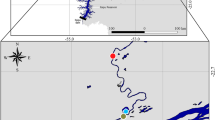Summary
The effect of increased habitat heterogeneity in tidal areas on coexistence between Palaemon prawns was studied at eight sites along the European Atlantic coast. Two species which are sympatric in non-tidal areas, Palaemon adspersus Rathke and P. squilla (L.) are largely allopatric in tidal areas, and the sympatric size difference decreases in allopatry. In tidal areas the smaller species, P. squilla, is restricted to brown algal belts and rockpools. A third species, P. serratus (Pennant), larger than the others, occurs under oceanic salinities in subtidal brown algal belts and there has forced P. squilla to restrict its habitat distribution to adjacent intertidal rockpools. At estuarine salinities, however, P. squilla also inhabits the brown algal belts. A larger diel variation in stomach fullness index in P. squilla than in P. adspersus persists in non-tidal areas.
Abiotic factors probably restrict the two largest species, viz. P. adspersus and P. serratus, to subtidal environments; these species are sensitive to the extremes in salinity, temperature or O2 levels characteristic of the intertidal zone. Competition and/or predation probably relegates P. squilla to the intertidal zone. In non-tidal areas, where this zone is reduced, P. squilla increases its niche width and coexists with P. adspersus, and the size differentiation associated with sympatry may reduce interspecific competition.
Similar content being viewed by others
References
Ahlgren I, Ahlgren G (1976) Vattenkemiska analysmetoder, sammanställda för undervisningen i limnologi. Compendium, Institute of Limonology, Uppsala
Berg J (1979) Discussion of methods of investigating the food of fishes, with reference to a preliminary study of the prey of Gobiusculus flavescens (Gobiidae). Mar Biol 50:263–273
Berglund A (1980) Niche differentiation between two littoral prawns in Gullmar Fjord, Sweden: Palaemon adspersus and P. squilla. Holarct Ecol 3:111–115
Berglund A (1981) Sex dimorphism and skewed sex ratios in the prawn species Palaemon adspersus and P. squilla. Oikos 36:158–162
Berglund A, Bengtsson J (1981) Biotic and abiotic factors determining the distribution of two prawn species: Palaemon adspersus and P. squilla. Oecologia (Berl) 49:300–304
Cody ML (1974) Competition and the structure of bird communities. Princeton University Press, New Jersey
Colwell RK, Futuyma J (1971) On the measurement of niche breadth and overlap. Ecology 52:567–576
Connell JH (1980) Diversity and the coevolution of competition, or the ghost of competition past. Oikos 35:131–138
Daniel MJ, Boyden CR (1975) Diurnal variations in physicochemical conditions within intertidal rockpools. Fld Stud 4:161–176
Doty MS (1957) Rocky intertidal surface. In: Hedgpeth JW (ed) Treatise on marine ecology and paleoecology I: Ecology. Geol Soc Am Mem 67:535–585
Forster GR (1951a) The biology of the common prawn, Leander serratus Pennant. J Mar Biol Ass UK 30:333–360
Forster GR (1951b) Notes on Leander squilla L. J Mar Biol Ass UK 30:361–367
Goss-Custard S, Jones J, Kitching JA, Norton FRS and T Fl (1979) Tide pools of Carrigathorna and Barloge Creek. Philos Trans Soc Lond Biol Sci 287:1–44
Grant PR (1972) Convergent and divergent character displacement. Biol J Linn Soc 4:39–68
Höglund H (1943) On the biology and larval development of Leander squilla (L.) forma typica de Man. Svenska Hydrografisk-Biologiska Kommissiones skr. Ny serie: Biologi II, 6:1–44
Kohn AJ, Nybakken JW (1975) Ecology of Conus on Eastern Indian Ocean fringing reefs: diversity of species and resource utilization. Mar Biol 29:211–234
Leviten PJ, Kohn AJ (1980) Microhabitat resource use, activity patterns, and episodic catastrophe: Conus on tropical intertidal reef rock benches. Ecol Monogr 50:55–75
Pyefinch KA (1943) The intertidal ecology of Bardsley island, North Wales, with special reference to the recolonization of rock surfaces, and the rockpool environment. J Anim Ecol 12:82–108
Richard P (1978) Tolérance aux températures extrêmes de Palaemon serratus (Pennant), influence de la taille et de l'acclimation. J Exp Mar Biol Ecol 35:137–146
Rodriguez G, Naylor E (1972) Behavioural rhythms in littoral prawns. J Mar Biol Ass UK 52:81–95
Author information
Authors and Affiliations
Rights and permissions
About this article
Cite this article
Berglund, A. Coexistence, size overlap and population regulation in tidal vs. non-tidal Palaemon prawns. Oecologia 54, 1–7 (1982). https://doi.org/10.1007/BF00541099
Received:
Issue Date:
DOI: https://doi.org/10.1007/BF00541099




